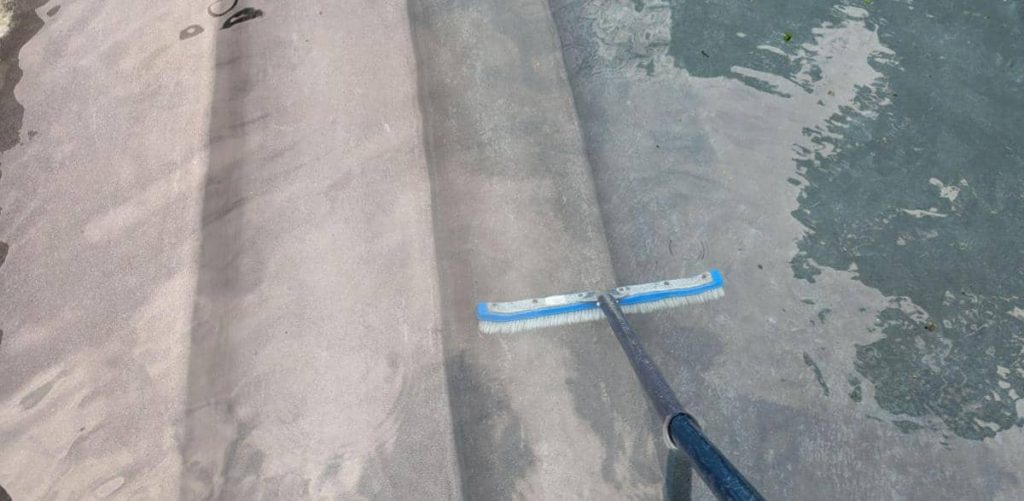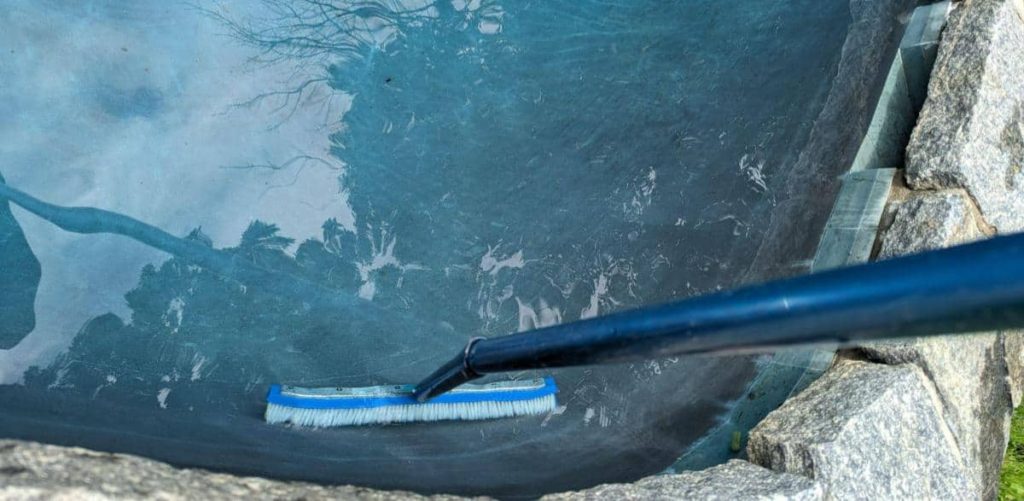Brushing your pool is an easy enough task, but it is an important part of overall pool cleaning and maintenance.
It helps disperse algae, dirt, and other contaminants from the pool’s surface, improving overall appearance and health.
But there are a few factors to consider when you brush a pool, such as the type of brush to use and when and how often to brush.
Why Do You Need to Brush a Pool?
Sure brushing is important, but let’s understand why it’s important and what the benefits are:
- Removes dirt and debris from walls to prevent staining: Whether from a storm or just leaves and debris falling from a tree, it may accumulate on the walls and surface. Brushing helps prevent major buildups or organic stains on the walls.
- Prevents algae growth: Brushing your pool will prevent algae spores from attaching to the surface and growing in the pool. This will help avoid any potential outbreaks.
- Dissolve and disperse chemicals: Some chemicals, like cal hypo or calcium chloride, can scale or stain a pool surface if it settles on the walls. Brushing helps to dissolve and disperse these chemicals so they won’t harm or etch the pool’s surface.
Know Which Type of Brush to Use For Your Pool
It’s important to take note of the different kinds of brushes that are available. Depending on the type of pool surface you have should determine what kind of brush that is used.
Nylon brushes are made for softer pool surfaces. These brushes should be used on vinyl, fiberglass, and above-ground pools. Also, if you have a concrete pool that is painted, you should be using a nylon brush so the paint doesn’t chip.
18" heavy-duty brush with nylon bristles to clean pool walls, tiles, and floors.
Stainless steel brushes are for surfaces that are harder. Unpainted concrete, plaster, and gunite surfaces with quartz or pebble finishes should use a stainless steel brush.
18" heavy-duty brush with stainless steel bristles for harder pool surfaces.
How to Brush Your Swimming Pool
In order to brush a pool, you’ll need a telescopic pole that attaches to the brush. These poles can range from 2 feet and extend up to 20 feet if necessary. However, any extension between 12 and 16 should be plenty enough to reach every corner of your pool.
Start from the Shallow End

Begin brushing from the pool’s shallow end, moving towards the deep end. This direction ensures that the dislodged debris settles at the bottom of the deep end, making it easier to vacuum the pool later.
Start with any benches, steps, sun shelf, or beach entry, and continue to work your way to the shallow end floors and walls.
Thoroughly Brush the Pool Walls

Use long strides along the walls, ensuring all corners and hard-to-reach areas are accounted for.
Reach every square foot of the pool so all the dirt and contaminants get dislodged.
Brushing Around the Pool Fixtures
Any lights, slides, and ladders need extra attention when brushing. Algae can hide in small areas that are least likely to be brushed routinely.
You may even need to remove the light and srub inside the niche.
Brushing the Pool Floor
After brushing the walls and all other accessories, proceed to brush the pool floor. Extend your pole as much as you can so that you can reach the middle of the deep end.
Try and brush towards the main drain or the center part of the deep end to make vacuuming easier.
Use Extra Force for Stained Areas
Don’t feel like you need to be gentle when brushing. It should almost feel like a workout at the end. Use some extra oomph for areas that are susceptible to stains or that have already stained.
Removing the Dirt and Debris
This is the satisfying part of the process — removing all of the debris!
Once you’ve completed brushing, it’s time to remove the dislodged debris and algae. This process is usually done using a pool vacuum or even a skimmer net for larger debris like leaves and sticks.
Using Automation to Brush
It’s not a secret that brushing can be a long process, not to mention the potential soreness afterward.
If manually cleaning and brushing the pool isn’t something that you are capable of doing, there are pool robots that do the brushing and vacuuming for you. They can be very convenient and can keep your pool looking clean 24/7.
However, they can incur a hefty upfront cost, so it is up to you to determine how much your time and effort cost in the long run!
How Often Should You Brush Your Pool
For regular and routine pool maintenance, brushing once a week is the typical recommendation.
However, if your pool is frequently used or exposed to a lot of dirt and debris, you might need to brush it more often.
There are also other factors to consider when it comes to brushing frequency:
- New Pool Plaster Finish: Whether you built a new plaster pool or just got a new replaster finish, brushing must be more frequent. We are talking two times per day, maybe even more! Unfortunately, a robot cannot be used during the curing time of new plaster. Read more on the plaster start-up procedure.
- Algae outbreak: If you happen to have an algae problem, you will need to brush frequently when trying to eliminate it. This is often done by shocking the pool which requires multiple brushings to ensure algae does not latch onto the pool surfaces.
Crushing the Brushing!
The process seems pretty easy, and it is. Routine pool brushing contributes to a cleaner, healthier, and more appealing swimming pool.
Remember, there is no such thing as too much brushing!


